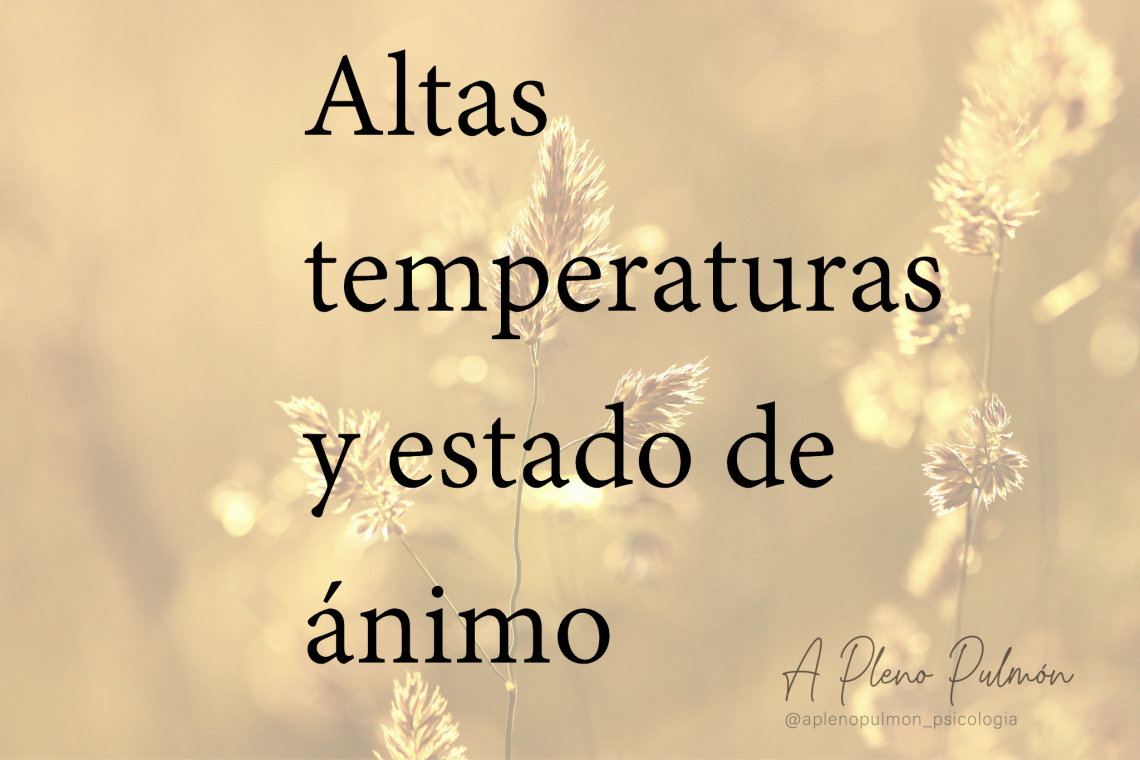Los efectos del cambio climático cada vez se hacen más notables y en el hemisferio norte este 2022 estamos viviendo un verano especialmente caluroso. Cada vez más, las personas expertas advierten de que este podría ser el verano más frío del resto de nuestras vidas, lo cual no es más que una pequeña muestra de la situación tan complicada a la que estamos llegando.
Estoy segura de que, tanto si eres de las personas que tienen la suerte de poder estar descansando, como si eres de las que aún continúan trabajando, estos meses habrás podido tener especialmente presente cómo a la par que altas temperaturas han aparecido cambios en tu cuerpo y por ende, también en tu mente (o viceversa). Entonces, ¿El calor afecta a cómo nos sentimos emocionalmente? Vamos a verlo.
"Sabemos que mente y cuerpo funcionan como sistema, nunca podemos verlos por separado como si trabajasen de manera independiente"

La respuesta es sí
En realidad hay multiplicidad de factores que pueden influir en nuestro estado de ánimo que están directa o indirectamente relacionados con el clima. Por ejemplo, cuando hablamos de clima podemos señalar qué efectos tienen la humedad o la cantidad de horas de sol a las que nos exponemos como hicieron algunos estudios citados al final del artículo 1, 2, 3, 4, 6. En este caso nos centraremos en las altas temperaturas, aunque sin perder de vista la idea de que en nuestro día a diferencia de un laboratorio no podemos aislar las variables, es decir, no podemos estar en un espacio en el que únicamente me afecte el cambio de temperatura porque lo más probable es que me estén afectando muchas otras cosas al mismo tiempo.
"Nos desenvolvemos en un entorno en el que estamos en constante intercambio: nos influye así como influimos en él"

- Algunos de los resultados que estos equipos de investigación encontraron cuando sometieron a las personas a altas temperaturas fueron:
- Reducción de la ansiedad y del escepticismo
- Alteraciones del sueño, irritabilidad y estado de ánimo disfórico
- Cambios comportamentales, más específicamente conductas agresivas
- Apatía
- Menor predisposición a ayudar a otras personas
Por el contrario, un clima agradable se relacionó con mejores habilidades cognitivas (podían desenvolverse con mayor soltura en las tareas y retos que se les planteaban) y un mejor estado de ánimo 5.
"Someterse a temperaturas altas puede provocar que desempeñemos peor las tareas, que sintamos mayor apatía, nos mostremos más irritables o se alteren nuestros ritmos de sueño entre otros. "
Otras alteraciones graves del estado de ánimo por el clima
Hace relativamente no tanto tiempo se consiguió que se reconociese como diagnóstico el Trastorno Afectivo Estacional (TAE). Este trastorno lo viven personas que padecen episodios depresivos de manera cíclica que se corresponden con épocas concretas del año: generalmente el otoño y el invierno (aunque en algunos casos muy poco frecuentes aparecen en primavera y verano). En este artículo hablamos sobre la depresión y cuáles son sus síntomas. En este caso no estaríamos refiriéndonos a excesos de temperatura, sino más bien pareciera que los factores climáticos estuvieran afectando al organismo desde la carencia de luz o incluso de calor, sin embargo aún hoy no se tienen claras las causas. Se cree que las razones por las que se desarrolla tienen que ver con distintas causas, algunas de ellas ambientales (aunque no todas referidas al clima), y otras genéticas.
"El Trastorno Afectivo Estacional lleva a las personas a vivir episodios de depresión de manera cíclica asociados a meses del año marcados por estaciones concretas "
Para terminar…
Ser conscientes de los efectos que las partes que componen el lugar que habitamos tienen en nosotras es muy importante de cara a nuestra salud mental. Asimismo, a veces podemos encontrarnos con efectos indirectos derivados. Por ejemplo, un estado de ánimo más alto o más bajo sabemos que influye en nuestra toma de decisiones y en la percepción de las cosas que nos suceden; si esto perdura en el tiempo estaremos construyendo nuestra imagen sobre quién somos en base a algo que en realidad está influyendo sobre nosotras de manera, que llega desde fuera, pero lo estamos integrando y tomándolo como propio.
Si sintieras que esto o algo parecido te pudiera estar sucediendo te animamos a que puedas informarte sobre el tema y buscar apoyo en vínculos seguros. Si necesitases consultarnos algo podemos estar en contacto a través de este formulario, en el que trataremos de contestar tan pronto como nos sea posible.
Asimismo, puedes suscribirte a nuestra Newsletter para recibir materiales gratuitos, novedades y promociones.
Gracias por llegar hasta aquí,
Alba de A Pleno Pulmón.
Agradecimientos a @pixabay, @markusspiske, @lucasmenesesphoto por su colaboración fotográfica.
Referencias:
1 Howarth, E. & Hoffman, M.S. (1984). A multidimensional approach to the relationship between mood and weather. British Journal of Psychology, 75(1), 15-23.
2 Rotton, J. y Cohn, EG (2004). Temperatura exterior, control climático y agresión criminal: la ecología espacial y temporal de la violencia. Ambiente y Comportamiento, 36(2), 276-306.
3Cohn, E.G. & Rotton, J. (2005). The curve is still out there: A reply to Bushman, Wang, and Anderson’s (2005) ‘Is the curve relating temperature to aggression linear or curvilinear?’ Journal of Personality and Social Psychology, 89(1), 67-70.
4 Anderson, C.A. (1987). Temperature and aggression: Effects on quarterly, yearly, and city rates of violent and nonviolent crime. Journal of Personality and Social Psychology, 52(6), 1161-1173.
5 Keller, Mateo C.; Fredrickson, Bárbara L.; Ybarra, Óscar; Côté, Stéphane; Johnson, Kareem; Mikels, Joe; Conway, Ana; Apuesta, Tor; (2005). Un corazón cálido y una cabeza clara: los efectos contingentes del clima en el estado de ánimo y la cognición. Ciencias Psicológicas, 16(9),724-731.
6Cao, M., & Wei, J. (2005). Stock market returns: A note on temperature anomaly. Journal of Banking & Finance, 29(6), 1559-1573.
7 Mood, W. C. A. P. S. Chiropractic Podcast Can The Weather Predict Your Moods?.
8 Cunningham, M.R., 1979. Weather, mood and helping behavior: Quasi-experiment with the sunshine samaritan. Journal of Personality and Social Psychology 37, 1947–1956.
9 Schneider, F.W., Lesko, W.A., Garrett, W.A., 1980. Helping behavior in hot, comfortable and cold temperature: A field study. Environment and Behavior 2, 231–241.





